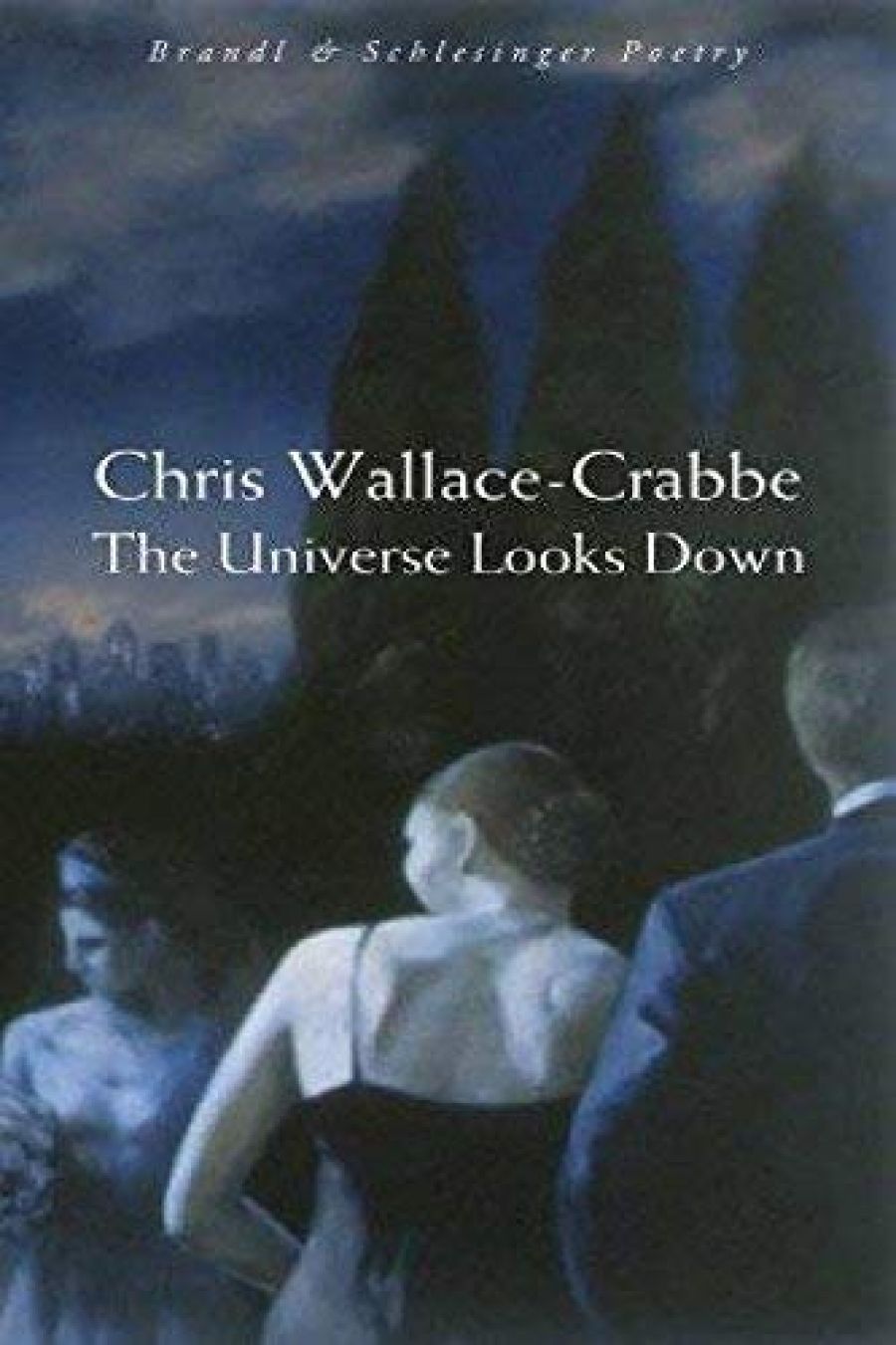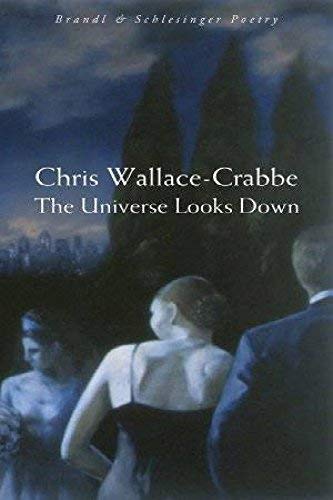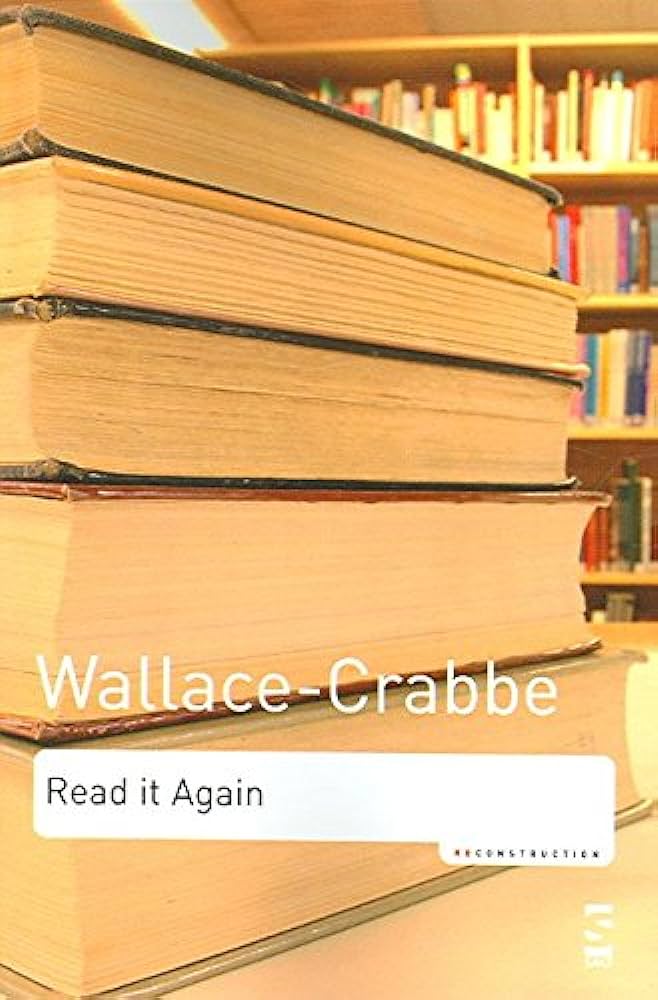
- Free Article: No
- Contents Category: Poetry
- Review Article: Yes
- Article Title: An intensified bag of tricks
- Online Only: No
- Custom Highlight Text:
Chris Wallace-Crabbe’s essay ‘Poetry and the Common Language’, in his collection Read It Again, begins: ‘If there is one thing we can say about poetry, it is this: like it or not, poetry turns out to be something special, an intensified bag of tricks with certain rules of its own.’ The deceptively casual style of the writing underscores its argument about the centrality of ‘voice’ in any poem (or essay) worth its salt: ‘interest, in poetry, is not only interesting, to put it very mildly; it also adds value. It lifts the game; often because it artistically combines an air of untidy casualness with lightly strategic effects which displace or realign us as we read.’
- Book 1 Title: The Universe Looks Down
- Book 1 Biblio: Brandl & Schlesinger, $26.95 pb, 67 pp
- Book 1 Cover Small (400 x 600):

- Book 1 Cover (800 x 1200):

- Book 2 Title: Read It Again
- Book 2 Biblio: Salt, $45 pb, 142 pp
- Book 2 Cover Small (400 x 600):

- Book 2 Cover (800 x 1200):

The Universe Looks Down, Wallace-Crabbe’s much-awaited ‘long poem’, is one very memorable ‘bag of tricks’. I have to confess to be resistant to most contemporary narrative poems; my first reaction to this one was like my first reactions to Vikram Seth’s and Dorothy Porter’s work – too many tricks, too much artful bathos, perhaps. But as with The Golden Gate (1986) and The Monkey’s Mask (1994), I’ve learnt to ‘Read It Again’; I seem to need a few deft tugs on the rope before I get into the rhythms the organ-grinder means me to dance to. The poem’s structural basis is a seven-line stanza written in decasyllables (with variations); the last word of the first line is echoed at the end of the stanza, and lines 5 and 6 rhyme, sometimes grudgingly – ‘(Better pop in a rhyme)’. The rough-hewn effect is engaging, as the verse form gives full scope for language that swings between the demotic and the arcane. Wallace-Crabbe’s is an art which conceals art, as he weaves a web of language which is ‘cool’ in both Graves’s sense of the word and its derivative in pop culture. There is at least one swipe at the excesses of postmodernism as preached in the academy –‘sexy, garble-friendly crap / Third hand from Paris: their pack rots the age’ – but this is a very postmodern sort of poem, highly self-conscious, fizzing and leaping along from one subject, time and place to another, delighting in confusion and dislocation. Its human ‘questers’, from seer to Icelandic hero, tribal elder to aviator and explorers, streetwise young women and latte-drinking Lotharios, are a set of shameless shape-changers; sometimes the reader struggles to keep up, so it’s reassuring to be told quite late in the piece, ‘These characters of mine do get around’. (Long ago, Wallace-Crabbe noted his dislike of ‘character’ in poetry, in the light of some of the poems being written at the time by his friends Gwen Harwood and Alec Hope.) Universe, which reflects and celebrates half a century of reading and friendship (Njalssaga to Vincent Buckley, via Ariosto and Auden), laughs in the face of the unities of time and place:
My story flows both in and outside time,
Which is a nuisance, I’m afraid.
With Brian McFarlane I should, long ago
Have contracted realism like a ’flu,
Or hepatitis C …
Milena, proclaimed as the poem’s scribe, the girl with the tabula rasa, collapses into the ‘I’ of the Australian scholar-poet, himself the most bewildering quester of them all: ‘And in the end Milena was myself, / The framer of the dance …’
The epilogue is prefaced by one of Gwen Harwood’s meditations on the nexus between memory, imagination and reality; equally apposite would have been her ‘Great questions all have wavering answers’. Universe, in all its play with questions of identity and the nature of meaning, is a poem about the wonder of what it is to be fully alive in the world, the world that is folding back upon itself and beckoning the questing mind to contemplate its own mortality. There are some moments when we are lifted into a realm where all is rich and strange, as here:
We spin with sharp stars in the autumn sky
Lost in the dumb immensity of space.
We fade. We leave our fragile stories
As magpies leave their little lives in air.
The gene has to use us, after all,
Hungry and prodigal,
Working its biochemistry under a sky
Famous for indifference …
Wallace-Crabbe’s imaginary flight takes off and returns to the local and the historically specific. There is a shaggy-doggish sort of prologue, which rings (or so I take it) some brilliant changes on the procession of kings of Scotland in Act 4 of Macbeth. In Universe, instead of eight future rulers beheld by a present non-legitimate monarch, we have a catalogue of eight prime ministers past and one prime minister present: ‘little Giglamps with his mania for / Pushing the country into some useful war.’ So what has this to do with the ‘rope of stories’ that follows? Not much at all, I suspect, if we want to read the work as a narrative poem-with-characters-and a plot – which is just what it isn’t.
The poem’s title acknowledges the age-old quest to perceive order and harmony, and the concomitant fear that all our clearest vision might be (quoting Wittgenstein, in the epigraph to Part Two) nothing more than ‘a tiny picture taken from an oblique, distorting angle’. But there are certain satisfactions to be gained from the idiosyncratic perspective: ‘The One Big Picture is better off unread, / Most of the time.’ Wallace-Crabbe returns to this idea in one of the essays in Read It Again, in a wise and witty discussion of past and present culture wars in Australia. Following Archilocus, he distinguishes between the way of the hedgehog (‘who has one big picture: that the way of generations explains all … the avant-garde and the conservative academy are just manifestations of this big binary picture’) and the way of the fox. We are fortunate to have as critic and cultural anatomist a writer who understands the hedgehog but has a temperament that leads him down the darting and sometimes devious paths of Reynard – ‘the fox reads history for its smaller details, noting that there are many little pictures’.
Read It Again establishes Wallace-Crabbe’s position as a major cultural commentator; the book demands to be read again and again. (When Salt reissues Read It Again, they will surely sweep up the pepperings of typos.) Not surprisingly, its main focus is on poetry, and in particular on the ways in which poets use language. Hardly a new subject? No: but what is new and refreshing about some of these essays on language is the incisiveness of their analysis; the distinction made in the first essay between ‘wisdom’ and ‘mimesis’ is one of many illuminations. The reader is of-ten given fresh insights and encouraged to make new connections as the argument moves from Derrida to Davie, from Bachelard to Buckley, Hope to Heaney, Heaney to Porter. (I confess that one of my few disappointments was that the essay on this last pair, rich in one mature poet’s appreciation of another’s language, has relatively little to say about Porter’s poetic syntax and vocabulary.) In recent months, I have been reading Wallace-Crabbe’s copious diaries and journals, and in reading these essays I have noted again and again how his jottings about the parallels and differences between the languages of poetry, music and painting have been woven into a com-plex and multifaceted argument about artistic expression. We have all too few poets (let alone critics) who have this kind of range and depth of intelligence. The last essay in the collection, ‘The Escaping Landscape’, picks up and develops, sonata-fashion, a theme that is introduced in the first, and played with variations along the way. Here, the meditation on Fred Williams’s contribution to landscape painting proceeds seamlessly from the verbal landscape-makings of Judith Wright and Les Murray, so that there is a kind of two-way illumination. Australian cultural commentary needs more of this kind of imaginative and highly informed border crossing. I am sure that I am not the only reader who is drawn in by Wallace-Crabbe’s sheer cheekiness, as he dares to title one essay ‘On the Personality of Keats’, and another, ‘Nolan, Kelly, and Co.’. Who would have thought that there was any-thing new to say about these cultural behemoths?
‘In the Pop Age’ explores what postmodernist formations might have to offer to poets. His examples here are three very different writers: Ania Walwicz, John Scott and Michael Farrell, all of whom he admires. What he has to say of them is simultaneously provocative and enlightening:
In each case a strongly distinctive voice and – dare I say it? – personality keeps making itself felt through the poems. In each case, inside the distancing language games theme is a tough little cookie battling to get out. However fragmented by historical and academic forces, the federated self still includes a coded yet audible ego.
The remark is also true of The Universe Looks Down. Wallace-Crabbe’s sensibility is attracted in equal measure to the contemporary and to the classical, the local and the international. How refreshing it is to find Marvell and Christopher Brennan grazing in the same paddock, how exhilarating to discover that there is still something new to say about ‘a green Thought in a green Shade’. What Graves wrote about the powers of the shaping mind in another poem that turns up-on simple imagery of colour and light has a bearing upon Chris Wallace-Crabbe’s distinguished achievement. The true poet has the ability to rend the imprisoning ‘cool web’, to show us how language can provide release from the sea-green brininess and volubility in which most of us risk daily drowning.


Comments powered by CComment